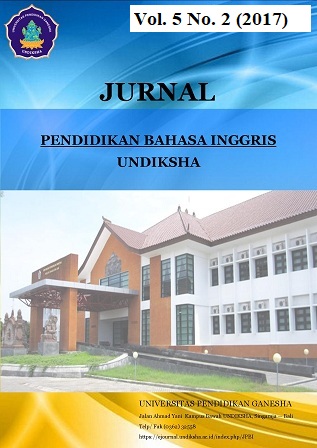An Analysis of Grammatical Errors in Writing Recount Text Committed by the 8th Grade Students of SMP Negeri 1 Seririt
DOI:
https://doi.org/10.23887/jpbi.v5i2.12124Abstract
Dirancang sebagai penelitian deskriptif-kualitatif, studi ini ditujukan untuk mengetahui jenis-jenis kesalahan yang dilakukan oleh siswa-siswa kelas 8 SMP Negeri 1 Seririt beserta sumber-sumber kesalahan yang mempengaruhinya. Subjek penelitian ini adalah 30 orang siswa kelas 8 SMP 1 Seririt dan objek penelitian ini adalah kesalahan-kesalahan gramatikal yang dilakukan oleh siswa. Dalam penelitian ini, tulisan siswa dianalisis dengan menggunakan taksonomi Azar mengenai tipe-tipe kesalahan dan klasifikasi sumber kesalahan oleh Brown. Hasil studi ini menunjukkan bahwa ada total 447 kesalahan gramatikal yang dilakukan oleh siswa. Tipe kesalahan yang paling dominan ditemukan adalah kesalahan bentuk kata kerja (verb tense) sebanyak 22.82%, diikuti dengan kesalahan diksi (word choice) sebanyak 16.33%, pengurangan kata (omit a word) sebanyak 11.19%, penambahan kata (add a word) sebanyak 10.51%, kapitalisasi (capitalization) sebanyak 7.38%, ejaan (spelling) sebanyak 5.82%, tunggal-jamak (plural-singular) sebanyak (4.47%),tanda baca (punctuation) sebanyak (4.47%), arti tidak jelas (meaning not clear) sebanyak 4.25%, bentuk kata (word form) sebanyak 4.03%, kalimat beruntun (run on sentence) sebanyak 3.36%, kalimat tidak lengkap (incomplete sentence) sebanyak 2.91%, susunan kata (word order) sebanyak 2.01% dan kesalahan artikel (article error) sebanyak 0.45%. Sedangkan sumber kesalahan yang paling dominan ditemukan adalah faktor intralingual (interlingual factor) sebanyak 62.67%, diikuti oleh strategi komunikasi siswa (communication strategy) sebanyak 29.42%, faktor interlingual (interlingual factor), dan konteks pembelajaran (context of learning) sebanyak 0.68%.Kata Kunci : kesalahan gramatikal, analisis kesalahan, teks recount.
Designed as descriptive qualitative study, this research aimed at investigating the types of grammatical errors committed by the 8th grade students of SMP Negeri 1 Seririt in writing recount text as well as the sources of error affecting their writing. The subjects of this study were 30 grade 8 students of SMP Negeri 1 Seririt and the objects were grammatical errors committed by the students. In this research, students’ writings were analyzed by using Azar’s taxonomy of types of error and Brown’s classification of sources of error. The result of the study showed that there were 447 total grammatical errors committed by the students. The most frequent type of error committed was verb tense error (22.82%). It was followed by word choice error (16.33%), omit a word error (11.19%), add a word error (10.51%), capitalization error (7.38%), spelling error (5.82%), plural-singular error (4.47%), punctuation error (4.47%), meaning not clear (4.25%), word form error (4.03%), run on sentence (3.36%), incomplete sentence (2.91%), word order error (2.01%) and article error (0.45%). As for the sources of error, intralingual factor was found as the most common source of error affecting the students in writing recount text (62.67%). Then, it is followed by students’ communication strategy (29.41%), interlingual factors (7.42%), and context of learning (0.68%).
keyword : grammatical errors, error analysis, recount text.
Published
2017-10-25
Issue
Section
Articles
License
Authors who publish with the Jurnal Pendidikan Bahasa Inggris Undiksha agree to the following terms:- Authors retain copyright and grant the journal the right of first publication with the work simultaneously licensed under a Creative Commons Attribution License (CC BY-SA 4.0) that allows others to share the work with an acknowledgment of the work's authorship and initial publication in this journal
- Authors are able to enter into separate, additional contractual arrangements for the non-exclusive distribution of the journal's published version of the work (e.g., post it to an institutional repository or publish it in a book), with an acknowledgment of its initial publication in this journal.
- Authors are permitted and encouraged to post their work online (e.g., in institutional repositories or on their website) prior to and during the submission process, as it can lead to productive exchanges, as well as earlier and greater citation of published work. (See The Effect of Open Access)













